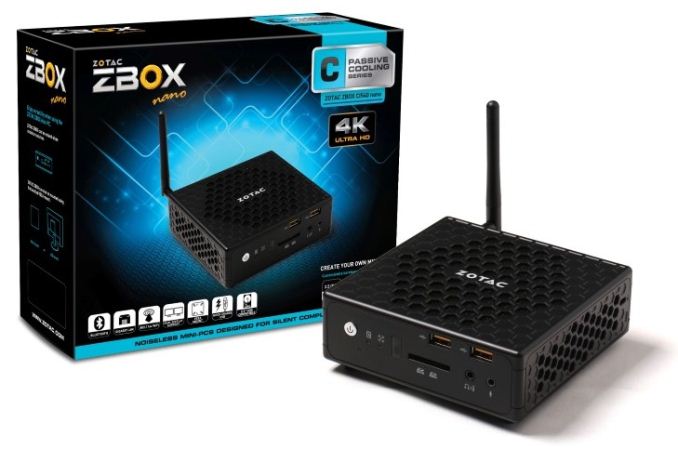Zotac ZBOX CI540 nano Review: A Fanless Haswell-Y mini-PC
by Ganesh T S on October 31, 2014 11:00 AM ESTFinal Words
Zotac's ZBOX CI540 nano provided us with the first opportunity to evaluate the performance of a Y-series CPU from Intel. The Core i5-4210Y is surprisingly powerful. Passively cooled systems are either very costly (particularly if they integrate powerful CPUs) or downright abysmal in performance (when they integrate the low-end / low-power CPUs such as the older Atoms). Zotac's offering with the ZBOX CI540 nano aims to strike a balance. $335 for a barebones configuration is quite reasonable for this type of system.
One of the aspects that we were worried about prior to evaluation was thermal throttling. Fortunately for Zotac, the Core i5-4210Y seems to keep the scenario design power (SDP) in mind while managing the internal clocks. Intel's intent with the Y-series is such that CPU performance needs to be talked about in terms of power consumption rather than absolute clocks. Outside the benchmarking circus, day-to-day workloads for the average mini-PC user actually fall rather nicely into the SDP aspect.
Pretty much the only downside of the unit is the unreasonably high idle power. Perhaps Zotac could look into some default BIOS optimizations to resolve that aspect. Other than that, the platform ticks everything needed in the mini-PC market - plenty of USB ports, quick charging capabilities, 802.11ac WLAN with Bluetooth integrated, a SD card reader and even a Display Port output along with the traditional HDMI. All these are packaged along with the Core i5-4210Y - one of the most powerful CPUs in the 11.5W TDP range. With the ZBOX CI540 nano, Zotac has managed to deliver the right balance of price and performance in the fanless mini-PC market.











48 Comments
View All Comments
MadMan007 - Friday, October 31, 2014 - link
Please disassemble and see if the plastic is in place on the thermal pad or not. Since this seems to be a retail unit and not a pre-production sample, it could help to answer the question posed on those links and verify that it is not a production unit issue.Also, while the relatively higher idle power draw could be fixed, when we're talking a difference of 2-4W it's not really that big a deal in absolute terms.
noelbonner - Tuesday, November 11, 2014 - link
Why don't people get a "real" mini-PC instead (such as they ones that are rated highly at http://tinyurl.com/obzllgb for example)?BinaryTB - Friday, October 31, 2014 - link
An IR port would have been nice, for use with remotes and such, but an external usb adapter is usually the only option these days it looks like.Also, would Steam In-Home Streaming benchmarks be worth testing on these devices? I know I use my HTPC sometimes in my living while my gaming desktop is elsewhere in the house (both devices on gigabit ethernet and nvidia hardware encoding on the host and intel hw decoding on the htpc client). Latency and such would be a good measure, assuming it would vary statistically for each device.
nathanddrews - Friday, October 31, 2014 - link
The external IR will probably be your only option for he foreseeable future. Newer HT gear can usually be networked and controlled via apps or browser sessions. Steam IHS is pretty solid even on wireless Atom devices, so it's probably pointless to review on an i5 with GbE. I'm with you, though, and would like to see a proper review of the IHS feature someday.meacupla - Saturday, November 1, 2014 - link
IR is so outdated.BT remote should be standard already.
Alexvrb - Sunday, November 2, 2014 - link
IR works and is probably the lowest power option there is. The less often I have to change remote batteries, the better.cjb110 - Monday, November 3, 2014 - link
Unless you want to use a universal remote...IR works and is lower power...the only advantage BT offers is less reliance on Line of Sight.BuddyRich - Monday, November 3, 2014 - link
IR is good for learning but if line of sight is a concern get an RF -> IR blaster and a remote that supports both IR and RF, some Harmony's, URCs, Philips do.jmorey - Monday, November 3, 2014 - link
Zotec says it has an integrated IR receiver and visually it appears that it does (see the transparent black plastic area between the WiFi LED and the memory card reader slot). Can someone confirm that? It is a required feature for me as I already have Harmony remotes that are IR only.josue16 - Friday, October 31, 2014 - link
Is this the only fanless pre-built Haswell based UCFF PC available?